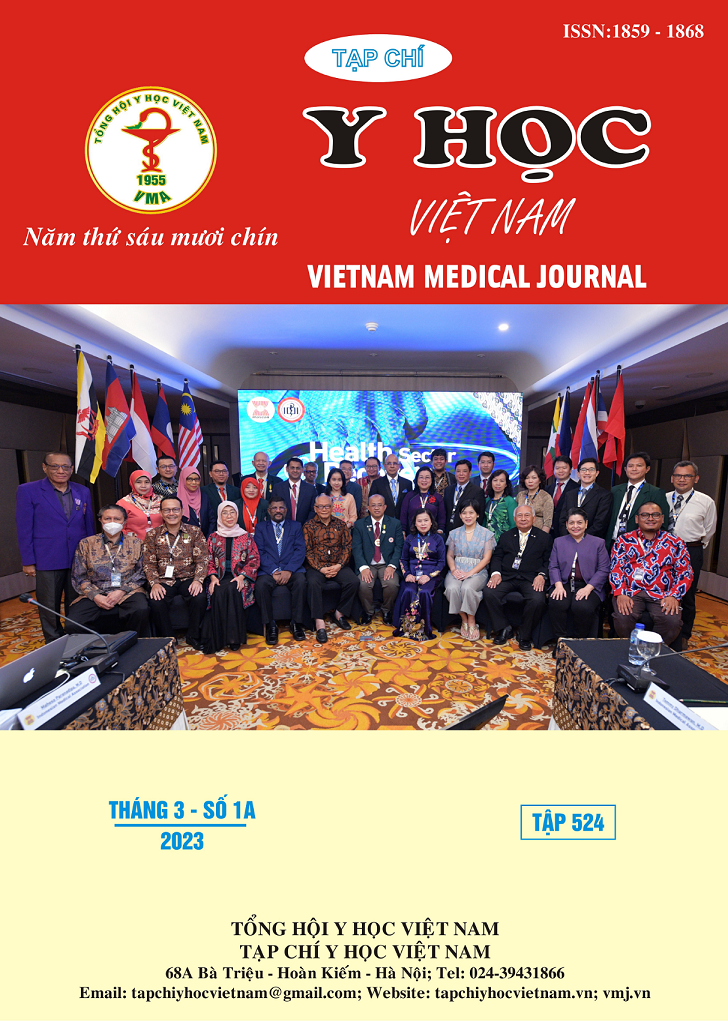ĐÁNH GIÁ CHỨC NĂNG DÂY THẦN KINH MẶT VÀ CÁC YẾU TỐ DỰ ĐOÁN SAU PHẪU THUẬT U DÂY THẦN KINH VIII SỬ DỤNG THEO DÕI THẦN KINH TRONG MỔ
Nội dung chính của bài viết
Tóm tắt
Mục tiêu: Đánh giá chức năng dây thần kinh mặt và các yếu tố liên quan sau phẫu thuật u dây thần kinh tiền đình thính giác sử dụng theo dõi thần kinh trong mổ. Đối tượng và phương pháp nghiên cứu: Mô tả cắt ngang, hồi cứu và tiến cứu trên 79 bệnh nhân được chẩn đoán u dây thần kinh tiền đình thính giác (u dây VIII) một bên và được phẫu thuật lấy u có theo dõi thần kinh trong mổ tại Bệnh viện Việt Đức từ tháng 10/2016 đến tháng 3/2018. Kết quả: tỉ lệ lấy hết u (65,82%), 10,12% trường hợp u còn lại kích thước từ 11-20mm; vị trí dây VII ở phía trước dưới (65,82%). Tỉ lệ liệt mặt ngay sau mổ là 9/79 BN (11,39%) giảm xuống sau 6 tháng là 5/79 BN (5,06%) và 12 tháng là 1/58(1,72%). Liệt mặt ngoại biên gặp chủ yếu ở nhóm u khổng lồ (36,83%) và sự khác biệt có ý nghĩa thống kê (p<0,05) ở nhóm lấy hết u và không lấy hết u. Kết luận: Kích thước u và mức độ lấy u liên quan đến chức năng dây VII sau mổ. Sử dụng hệ thống theo dõi thần kinh trong mổ làm giảm tỷ lệ tổn thương dây VII.
Chi tiết bài viết
Từ khóa
U dây thần kinh số VIII, liệt dây VII, hệ thống theo dõi thần kinh
Tài liệu tham khảo
2. Lescanne E., Velut S., Lefrancq T. (2002) The internal acoustic meatus and its meningeal layers: a microanatomical study. J. Neurosurgery, 97: 1191-7.
3. Nguyễn Kim Chung, Nguyễn Phong, Võ Thanh Tùng (2014) Kết quả điều trị vi phẫu thuật 144 trường hợp u bao sợi dây thần kinh VIII. Y học Thành phố Hồ Chí Minh, 18(6): 360-5.
4. Amano M., Kohno M., Nagata O., et al. (2011) Intraoperative continuous monitoring of evoked facial nerve electromyograms in acoustic neuroma surgery. Acta Neurochir (Wien), 153(5): 1059-67; discussion 1067.
5. Myrseth E., Møller P., Pedersen P. H., et al. (2005) Vestibular schwannomas: clinical results and quality of life after microsurgery or gamma knife radiosurgery. Neurosurgery, 56(5): 927-35; discussion 927-35.
6. Ren Y., MacDonald B.V., Tawfik K.O., et al. (2020) Clinical Predictors of Facial Nerve Outcomes After Surgical Resection of Vestibular Schwannoma. Otolaryngology–Head and Neck Surgery, 164(5): 1085-1093.
7. Acioly M. A., Gharabaghi A., Liebsch M., et al. (2011) Quantitative parameters of facial motor evoked potential during vestibular schwannoma surgery predict postoperative facial nerve function. Acta Neurochir (Wien), 153(6): 1169-79.
8. Sughrue M. E., Kaur R., Kane A. J., et al. (2010) The value of intraoperative facial nerve electromyography in predicting facial nerve function after vestibular schwannoma surgery. J Clin Neurosci, 17(7): 849-52.
9. Fukuda M., Oishi M., Hiraishi T., et al. (2011) Intraoperative facial nerve motor evoked potential monitoring during skull base surgery predicts long-term facial nerve function outcomes. Neurol Res, 33(6): 578-82.
10. Lalwani A. K., Butt F. Y., Jackler R. K., et al. (1994) Facial nerve outcome after acoustic neuroma surgery: a study from the era of cranial nerve monitoring. Otolaryngol Head Neck Surg, 111(5): 561-70.


